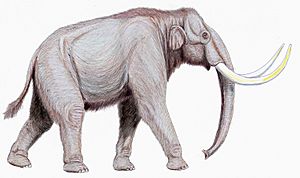West Runton Mammoth facts for kids

Steppe mammoth
|
|
| Alternative name | Mammuthus trogontherii |
|---|---|
| Location | Found at the base of a cliff on West Runton Beach |
| Region | West Runton, North Norfolk, United Kingdom |
| Type | Fossilized remains |
| History | |
| Periods | Cromerian Stage 866,000–478,000 years ago |
| Site notes | |
| Discovered | 1990 |
| Management | Norfolk Museums Service |
| Public access | Cromer Museum, Norwich Castle Museum & Art Gallery, Norfolk Collections Centre (Gressenhall Farm and Workhouse) |
The West Runton Mammoth is the fossilized (turned into rock over time) skeleton of a huge steppe mammoth (Mammuthus trogontherii). It was found in the cliffs of West Runton in Norfolk, England, in 1990. This discovery is super important because it's the largest and most complete mammoth skeleton ever found. It's also the oldest one discovered in the United Kingdom.
Contents
Discovering the Mammoth
The story of the West Runton Mammoth began after a big storm on December 13, 1990. Some local people were walking along the beach and noticed a very large bone sticking out from the bottom of the cliffs. They quickly contacted the Norfolk Museums Service. Experts from the museum came to look and figured out it was a hip bone from a giant steppe mammoth.
About a year later, after another storm, a local person who liked to hunt for fossils found even more bones. In January 1992, the Norfolk Archaeological Unit started digging to see what else was there.
Big Dig and Preservation
A much bigger dig happened in 1995 and lasted for three months. The Norfolk Archaeological Unit led this huge project. They got money from the Heritage Lottery Fund and Anglian Water to help pay for it. During the dig, they carefully mapped and recorded everything. This included details about animal remains, other fossils, the layers of soil, and even the types of minerals and chemicals present. They even sifted through almost ten tons of soil to find tiny bones from amphibians, mammals, and birds.
To protect the bones, workers wrapped them in tissue paper and foil. Then, they covered them in plaster casts and used strong supports, like splints, to keep them safe. The mammoth's well-preserved skull and tusks needed a special cradle to hold them. On the very last day of the dig, a crane carefully lifted the skull and tusks out. After that, the big hole was filled back in.
Studying the Bones
The bones were taken to a special lab at Gressenhall for examination. There, scientists made an interesting discovery: the mammoth's body had been eaten by spotted hyenas! They found teeth marks on the bones and even some hyena droppings.
Scientists also learned that the mammoth had a sick and twisted right knee. This injury likely made it hard for the animal to move and probably led to its death, even though it was still quite young.
All the bones were carefully listed and organized. Smaller bones were put into special archive trays or boxes. For the larger, heavier bones, scientists made strong, custom-fit covers. These covers had a soft foam layer inside and a hard resin shell outside for support. The heaviest bones are stored on their own special trolleys. All the bones are kept in a building where the temperature and humidity are carefully controlled to keep them safe.
What We Learned from the Mammoth
The West Runton Mammoth skeleton is the best example of its kind, Mammuthus trogontherii, ever found. About 85% of its skeleton is complete! Before this, the most complete skeletons of this species found in Germany and Russia were only about 10 to 15% complete.
Scientists believe this mammoth was a male. It stood about 4 metres (13 ft) tall at its shoulder and would have weighed around 10 tonnes (11 short tons). That's twice as heavy as a modern African elephant!
Ancient Environment
By studying things like pollen, amphibians, snails, and small mammals found at the site, scientists could figure out what the area was like long ago. They think there were slow-moving freshwater bodies near the sea. There was also a lot of plants and moist woodland. The climate during the Cromerian Stage, when the mammoth lived, was similar to the climate in that area today. It was a warm period between ice ages.
Where to See the Mammoth Today
Because the West Runton Mammoth's bones are so big and heavy, only a few selected pieces are on display. You can see them at:
- Norwich Castle Museum
- Norfolk Collections Centre at Gressenhall Farm and Workhouse Museum
- Cromer Museum
Further Research
On March 30, 2011, scientists announced an amazing breakthrough. Researchers from the Universities of York and Manchester successfully got protein from the mammoth's bones! They used a super-powerful machine called a mass spectrometer to create a nearly complete sequence of collagen, a type of protein.
Before this, scientists didn't think it was possible to find any collagen in a skeleton that was around 600,000 years old. While some shorter protein pieces have been found in dinosaur fossils, this is likely the oldest protein ever fully sequenced. This research was part of a larger study looking at the proteins of mammoths and mastodons. Even though the fossil was incredibly old, they found enough protein from the West Runton skeleton to confirm it belonged to the elephantidae family, which includes elephants and mammoths.
Images for kids





